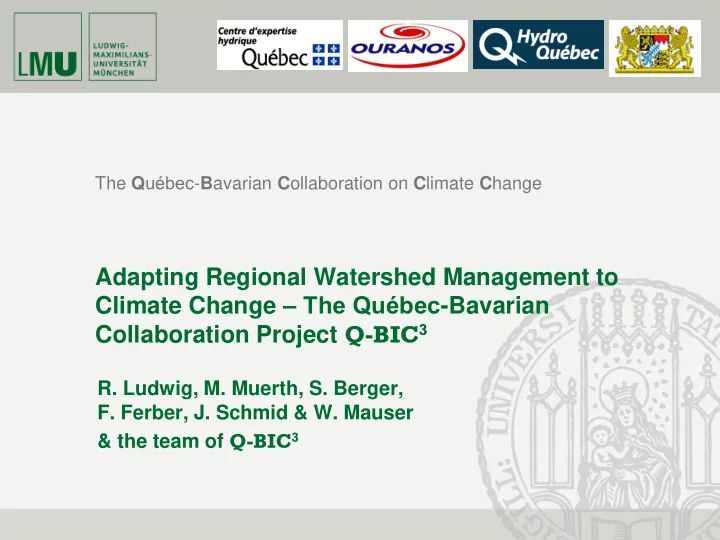

The Q uébec - B avarian C ollaboration on C limate C hange Adapting Regional Watershed Management to Climate Change – The Québec -Bavarian Collaboration Project Q-BIC 3 R. Ludwig, M. Muerth, S. Berger, F. Ferber, J. Schmid & W. Mauser & the team of Q-BIC 3
Q-BIC 3 Outline Outline of the presentation: Key issues of Q-BIC 3 The Ensemble of Climate Inputs & Hydrological Models Challenges for Water Management of the Danube-Main Transfer System Approaches to simulate adaptation of water management to Climate Change # 2 23.09.2010 HydroPredict 2010 Conference, Prague
Q-BIC 3 Key issues of Q-BIC 3 1. Identify impacts & adaptation options for water resource management in Q&B 2. Quantify & reduce projection uncertainties of the model chain 3. Investigate the required complexity of hydrological models to estimate CC impacts 4. Develop a regionally transferable and modular modeling system for integrated watershed management under CC # 3 23.09.2010 HydroPredict 2010 Conference, Prague
Q-BIC 3 Regions for the analysis [1] Gatineau (Rapides- Farmers; 23981 km²), [2] Saint Fracois (Weedon; 2922 km²), [3] Danube (Kehlheimwinzer; 26284 km²), [4] Altmuehl (Eichstaett; 1396 km²), [5] Isar (Munich; 2814 km²), [6] Regnitz (Pettstadt; 6991 km²) # 4 23.09.2010 HydroPredict 2010 Conference, Prague
Q-BIC 3 Uncertainty of projections Emission Scenarios Climate Modeling & Scenarios Hydrological models Management tools Adaptation strategies Cumulative uncertainty # 5 23.09.2010 HydroPredict 2010 Conference, Prague
Q-BIC 3 Ensemble of climate model data sets # 6 23.09.2010 HydroPredict 2010 Conference, Prague
Q-BIC 3 Ensemble of hydrological models 4 watersheds & 4 hydromodels (plus side projects) # 7 23.09.2010 HydroPredict 2010 Conference, Prague
Q-BIC 3 Challenges for water management I Regnitz river: • Tributary of the Main river • winter precipitation regime • little ground water storage • problem of low flows in summer Climate Change impacts? • dP may further reduce low flows • dT may increase water demand for irrigation # 8 23.09.2010 HydroPredict 2010 Conference, Prague
Q-BIC 3 Challenges for water management II Danube-Main water transfer: • transfers about about 150 mill. m 3 /yr • Brombach and Roth reservoirs built for that purpose • Even today competition between recreation & water management • Adjustment of rules and structures to Climate Change needed? # 9 23.09.2010 HydroPredict 2010 Conference, Prague
Q-BIC 3 Challenges for water management III Altmühlsee reservoir: • Flood protection for Altmühl • Water transfer to Regnitz via Brombach reservoir • Eutrophication! - floods transport suspended sediments from agricultural area, but no constant inflow (Climate Change!) # 10 23.09.2010 HydroPredict 2010 Conference, Prague
Q-BIC 3 Fuzzy Model of Water Management Fuzzy model of water transfer set up with The Danube-Main water knowledge-based transfer system is managed by fuzzification and de- human decisions based on fuzzification rules of reservoir and gauge levels management decision # 11 23.09.2010 HydroPredict 2010 Conference, Prague
Q-BIC 3 First results for Altmühl lake First results show that a Water Management Model based on Fuzzy Logic Theory may be appropriate to model the decisions made by water managers Input is upstream gauge, model computed all three possible water flow quantities # 12 23.09.2010 HydroPredict 2010 Conference, Prague
Q-BIC 3 Conclusions Conclusions Bias correction of RCM data is (still desperately) needed for hydromodel simulation Hydromodels produce different runoff curves even if calibrated on same gauge time series Reproduction of the annual cycle of runoff and the frequencies of high and low flows (or indicators!) are more important than R 2 etc. Because water management often uses thresholds, fuzzy logic seems to increase robustness and adjustability to uncertainties in simulated runoff # 13 23.09.2010 HydroPredict 2010 Conference, Prague
Q-BIC 3 Thank you Thank you very much for your attention!!! # 14 23.09.2010 HydroPredict 2010 Conference, Prague
Recommend
More recommend